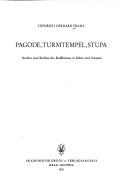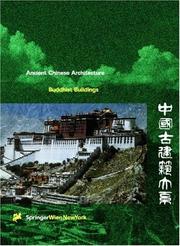| Listing 1 - 10 of 70 | << page >> |
Sort by
|
Book
ISBN: 0880669020 Year: 1984 Publisher: Monticello (Ill.): Vance bibliographies
Abstract | Keywords | Export | Availability | Bookmark
 Loading...
Loading...Choose an application
- Reference Manager
- EndNote
- RefWorks (Direct export to RefWorks)

ISBN: 9783201010498 3201010499 Year: 1978 Publisher: Graz: Akademische Druck- und Verlagsanstalt,
Abstract | Keywords | Export | Availability | Bookmark
 Loading...
Loading...Choose an application
- Reference Manager
- EndNote
- RefWorks (Direct export to RefWorks)
Buddhist architecture --- Architecture --- Buddhist architecture
Book
ISBN: 1785277502 1785277499 Year: 2021 Publisher: London : Anthem Press,
Abstract | Keywords | Export | Availability | Bookmark
 Loading...
Loading...Choose an application
- Reference Manager
- EndNote
- RefWorks (Direct export to RefWorks)
The Tämpiṭavihāras of Sri Lanka focuses on one distinctive Buddhist architectural practice from pre-modern Sri Lanka - the construction of Buddha image-houses on elevated wooden platforms supported by stone pillars. As a centre of Buddhism, Sri Lanka has a rich tradition of erecting Buddha image-houses, the origin of which dates to the fifth century. Yet, the ṭämpiṭavihāra tradition only existed from the thirteenth to the nineteenth centuries. The ṭämpiṭavihāra is an exceptional type of image-house, not only for its specific timeframe and unique construction technology, but also for its complex architectural conception of the Buddhist worldview and soteriology. This book examines the significant aspects of ṭämpiṭavihāra architecture and documents some of the distinctive examples of ṭämpiṭavihāra with an analysis of their architectural design and symbolic content.
Book
ISBN: 9780824835835 Year: 2013 Publisher: Honolulu : University of Hawaiʻi Press,
Abstract | Keywords | Export | Availability | Bookmark
 Loading...
Loading...Choose an application
- Reference Manager
- EndNote
- RefWorks (Direct export to RefWorks)
Buddhist architecture --- Asceticism --- Buddhism.
Book
ISBN: 9782855394145 2855394147 Year: 1981 Publisher: Paris: École française d'Extrême-Orient,
Abstract | Keywords | Export | Availability | Bookmark
 Loading...
Loading...Choose an application
- Reference Manager
- EndNote
- RefWorks (Direct export to RefWorks)
Book
Year: 2017 Publisher: Cologne : Modern Academic Publishing,
Abstract | Keywords | Export | Availability | Bookmark
 Loading...
Loading...Choose an application
- Reference Manager
- EndNote
- RefWorks (Direct export to RefWorks)
"This dissertation explores new ways of Buddhist temple construction in modern Japan and puts the ideas and motivations of their architects in contrast to the rather different determinations of this assignment described in Buddhist scholarly teachings. The study contains two surveys, a philological-philosophical analysis of what is argued in Buddhist teachings as the assignment of building a temple, and a historical outline of the architectural development from the 1870's onwards with a specific focus on how these temples were discussed as religious places. In contrast to what most literature on Japanese Buddhist temples suggests, many temple buildings in contemporary Japan are made from concrete. They have glass windows, air conditioning, and electric lights. Some of these buildings look like normal Japanese houses, others imitate the shape of traditional architecture whereas others are designed by world famous star architects. This study gives a detailed chronological overview of this recent architectural development by analyzing hundreds of temple buildings built in non-traditional ways. All these buildings show that not only the architectural appearance but also the idea of what it means to build Buddhist temple has changed over the last 150 years. There may be a lot of reasons for new views on temple construction since the late 19th century, but the most influential cause and indubitable premise of this change can be identified as the adoption of western concepts of art, aesthetics, and architecture in Japan. A fundamental part of these concepts is the idea that building a temple was a task assigned to architects, and these architects were artists by profession. Since that time one can observe a growing common thinking among these new architects, that part of their job was to leave behind traditional (i.e. religious) ideas in favor of realizing new architectural and artistic concepts. The significance of this shift becomes clear with a look on how the assignment of building a temple was described before the late 19th century. In the scholarly Buddhist tradition, building a temple has never been argued as a task for architects or artists but rather as a religious exercise. It demands a preparation of a place for the "three treasures", i.e. a dwelling place for a Buddha, a place for the Buddhist teachings, and a place for a Buddhist convention. Of course, the respective teachings are not construction manuals but mythological and liturgical texts, most of them sūtras or commentaries. But this is just why they discuss reasons why there are temples in Buddhism at all. And interestingly enough, sūtras contain such a place for the three treasures themselves, since in their opening passage there is always a description of a convention around a Buddha dwelling at a certain place and teaching the dharma. These descriptions vary depending on the scholarly tradition. They sometimes use terms like "maṇḍala" or "Pure Land" to describe the setting and occasionally depict the situation very accurately. Consequently conventions like these are one basic idea of the Buddhist liturgy, and especially maṇḍalas and Pure Lands are widely argued as structures that gave shape to Buddhist temples as places where this liturgy is set. Furthermore, and this seems to be much more important with regard to the perception of Buddhist temples as pieces of aesthetic art, especially the sūtras on the prajñā-pāramitā make clear that the greatest challenge is not a matter of building but of seeing the temple. If Buddhist temples were places to show the presence of a Buddha, it means their intention is to make visible what is invisible by definition. A human eye seeing such a dwelling Buddha in the temple does not see a dwelling Buddha in the temple at all, because the Buddha has entered nirvāṇa. But, and this is the crucial point the sūtras are arguing, this is just the way a human eye is actually seeing a Buddha dwelling in the temple. And only because temple architecture - as well as paintings, statues, gardens etc. - shows the presence of the Buddha in this way does it become a religious place where the Buddha is actually present. The final discussion of this study puts these Buddhist teachings in a dialogue with modern aesthetic architectural concepts argued by temple architects. The contrasting points of view make it clear that the explicitly Buddhist idea of Buddhist temple architecture can not be grasped by aesthetics, because its purpose is to show the invisible presence of the Buddha and not to be a sensual (i.e. aesthetic) experience of the visible object itself in the first place. However, aesthetic concepts of art have become common in Japan since the late 19th century. They are the foundation of the described new ways in which temples were built and designed since then. One indication for the impact of aesthetics are Japanese words like shimboru シンボル/shōchō 象徴 (symbol) or fun'iki 雰囲気 (atmosphere) which are used by architects to describe their temple architecture and matters of design. These words were formed around the turn of the century to express European concepts of art and aesthetics, since before that these words and ideas simply did not exist in Japan. And it is only since then, that temples were perceived as aesthetic symbols with various meanings that can be defined by an architect, and that they have a certain atmosphere which should be designed for making visitors feeling comfortable. Now it is the architect himself who gives meaning to its work and who is responsible for a nice spatial experience. But none of these architects is talking about himself becoming Buddha by building a temple. So not only the architectural appearance and construction of Buddhist temples have changed enormously throughout the last 150 years, but also the task of building itself. There has always been change in appearance and construction throughout the history of Buddhism and in the different Buddhist cultures, but the redefinition of the temple as an architectural piece of art is a very recent development in Japan and the actual new idea causing these dramatic architectural changes."
Book
ISBN: 8121507235 Year: 1997 Publisher: New Delhi Munshiram Manoharlal publishers
Abstract | Keywords | Export | Availability | Bookmark
 Loading...
Loading...Choose an application
- Reference Manager
- EndNote
- RefWorks (Direct export to RefWorks)

ISBN: 986763005X Year: 2003 Publisher: 新店 遠足文化事業有限公司
Abstract | Keywords | Export | Availability | Bookmark
 Loading...
Loading...Choose an application
- Reference Manager
- EndNote
- RefWorks (Direct export to RefWorks)

ISBN: 321183009X Year: 2000 Publisher: Wien Springer
Abstract | Keywords | Export | Availability | Bookmark
 Loading...
Loading...Choose an application
- Reference Manager
- EndNote
- RefWorks (Direct export to RefWorks)
Book
Year: 2017 Publisher: Cologne : Modern Academic Publishing,
Abstract | Keywords | Export | Availability | Bookmark
 Loading...
Loading...Choose an application
- Reference Manager
- EndNote
- RefWorks (Direct export to RefWorks)
"This dissertation explores new ways of Buddhist temple construction in modern Japan and puts the ideas and motivations of their architects in contrast to the rather different determinations of this assignment described in Buddhist scholarly teachings. The study contains two surveys, a philological-philosophical analysis of what is argued in Buddhist teachings as the assignment of building a temple, and a historical outline of the architectural development from the 1870's onwards with a specific focus on how these temples were discussed as religious places. In contrast to what most literature on Japanese Buddhist temples suggests, many temple buildings in contemporary Japan are made from concrete. They have glass windows, air conditioning, and electric lights. Some of these buildings look like normal Japanese houses, others imitate the shape of traditional architecture whereas others are designed by world famous star architects. This study gives a detailed chronological overview of this recent architectural development by analyzing hundreds of temple buildings built in non-traditional ways. All these buildings show that not only the architectural appearance but also the idea of what it means to build Buddhist temple has changed over the last 150 years. There may be a lot of reasons for new views on temple construction since the late 19th century, but the most influential cause and indubitable premise of this change can be identified as the adoption of western concepts of art, aesthetics, and architecture in Japan. A fundamental part of these concepts is the idea that building a temple was a task assigned to architects, and these architects were artists by profession. Since that time one can observe a growing common thinking among these new architects, that part of their job was to leave behind traditional (i.e. religious) ideas in favor of realizing new architectural and artistic concepts. The significance of this shift becomes clear with a look on how the assignment of building a temple was described before the late 19th century. In the scholarly Buddhist tradition, building a temple has never been argued as a task for architects or artists but rather as a religious exercise. It demands a preparation of a place for the "three treasures", i.e. a dwelling place for a Buddha, a place for the Buddhist teachings, and a place for a Buddhist convention. Of course, the respective teachings are not construction manuals but mythological and liturgical texts, most of them sūtras or commentaries. But this is just why they discuss reasons why there are temples in Buddhism at all. And interestingly enough, sūtras contain such a place for the three treasures themselves, since in their opening passage there is always a description of a convention around a Buddha dwelling at a certain place and teaching the dharma. These descriptions vary depending on the scholarly tradition. They sometimes use terms like "maṇḍala" or "Pure Land" to describe the setting and occasionally depict the situation very accurately. Consequently conventions like these are one basic idea of the Buddhist liturgy, and especially maṇḍalas and Pure Lands are widely argued as structures that gave shape to Buddhist temples as places where this liturgy is set. Furthermore, and this seems to be much more important with regard to the perception of Buddhist temples as pieces of aesthetic art, especially the sūtras on the prajñā-pāramitā make clear that the greatest challenge is not a matter of building but of seeing the temple. If Buddhist temples were places to show the presence of a Buddha, it means their intention is to make visible what is invisible by definition. A human eye seeing such a dwelling Buddha in the temple does not see a dwelling Buddha in the temple at all, because the Buddha has entered nirvāṇa. But, and this is the crucial point the sūtras are arguing, this is just the way a human eye is actually seeing a Buddha dwelling in the temple. And only because temple architecture - as well as paintings, statues, gardens etc. - shows the presence of the Buddha in this way does it become a religious place where the Buddha is actually present. The final discussion of this study puts these Buddhist teachings in a dialogue with modern aesthetic architectural concepts argued by temple architects. The contrasting points of view make it clear that the explicitly Buddhist idea of Buddhist temple architecture can not be grasped by aesthetics, because its purpose is to show the invisible presence of the Buddha and not to be a sensual (i.e. aesthetic) experience of the visible object itself in the first place. However, aesthetic concepts of art have become common in Japan since the late 19th century. They are the foundation of the described new ways in which temples were built and designed since then. One indication for the impact of aesthetics are Japanese words like shimboru シンボル/shōchō 象徴 (symbol) or fun'iki 雰囲気 (atmosphere) which are used by architects to describe their temple architecture and matters of design. These words were formed around the turn of the century to express European concepts of art and aesthetics, since before that these words and ideas simply did not exist in Japan. And it is only since then, that temples were perceived as aesthetic symbols with various meanings that can be defined by an architect, and that they have a certain atmosphere which should be designed for making visitors feeling comfortable. Now it is the architect himself who gives meaning to its work and who is responsible for a nice spatial experience. But none of these architects is talking about himself becoming Buddha by building a temple. So not only the architectural appearance and construction of Buddhist temples have changed enormously throughout the last 150 years, but also the task of building itself. There has always been change in appearance and construction throughout the history of Buddhism and in the different Buddhist cultures, but the redefinition of the temple as an architectural piece of art is a very recent development in Japan and the actual new idea causing these dramatic architectural changes."
| Listing 1 - 10 of 70 | << page >> |
Sort by
|

 Search
Search Feedback
Feedback About UniCat
About UniCat  Help
Help News
News